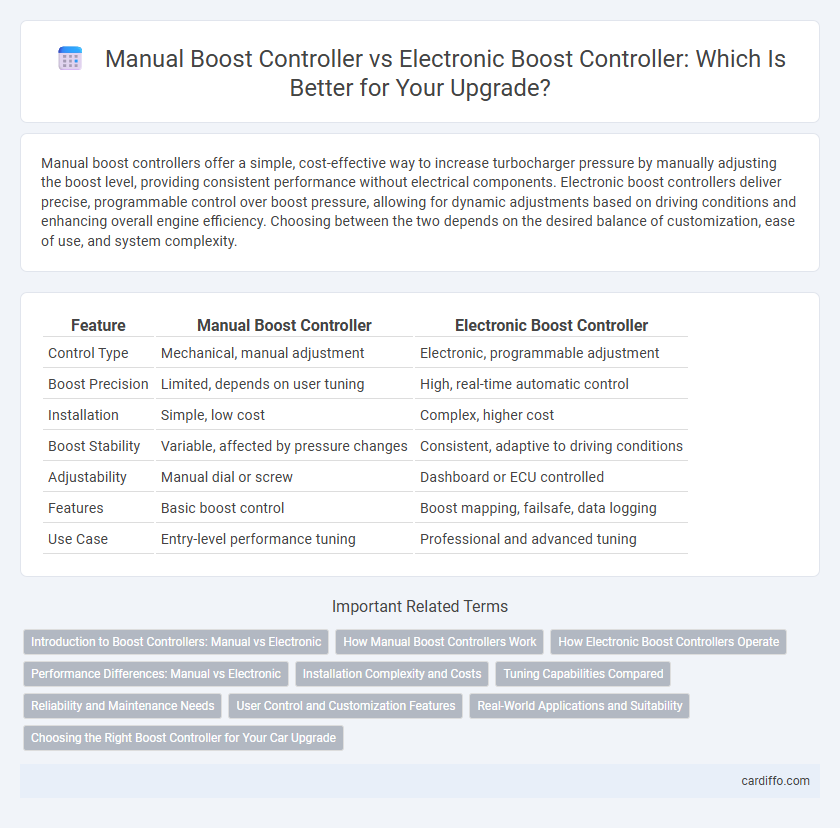Manual boost controllers offer a simple, cost-effective way to increase turbocharger pressure by manually adjusting the boost level, providing consistent performance without electrical components. Electronic boost controllers deliver precise, programmable control over boost pressure, allowing for dynamic adjustments based on driving conditions and enhancing overall engine efficiency. Choosing between the two depends on the desired balance of customization, ease of use, and system complexity.
Table of Comparison
| Feature | Manual Boost Controller | Electronic Boost Controller |
|---|---|---|
| Control Type | Mechanical, manual adjustment | Electronic, programmable adjustment |
| Boost Precision | Limited, depends on user tuning | High, real-time automatic control |
| Installation | Simple, low cost | Complex, higher cost |
| Boost Stability | Variable, affected by pressure changes | Consistent, adaptive to driving conditions |
| Adjustability | Manual dial or screw | Dashboard or ECU controlled |
| Features | Basic boost control | Boost mapping, failsafe, data logging |
| Use Case | Entry-level performance tuning | Professional and advanced tuning |
Introduction to Boost Controllers: Manual vs Electronic
Manual boost controllers offer a straightforward, mechanical method to regulate turbocharger pressure by adjusting a bleed valve, providing consistent boost levels with minimal complexity. Electronic boost controllers utilize solenoids controlled by a programmable unit, enabling precise boost adjustments, multiple boost targets, and adaptive performance optimization. Choosing between manual and electronic controllers depends on the desired level of control, tuning flexibility, and budget considerations for turbocharged engine setups.
How Manual Boost Controllers Work
Manual boost controllers regulate turbocharger pressure by controlling the airflow to the wastegate actuator using a simple mechanical valve. By adjusting this valve, the system increases or decreases boost pressure based on the driver's adjustments without electronic input. This straightforward design allows manual control over turbo boost levels but lacks the precision and adaptive features of electronic controllers.
How Electronic Boost Controllers Operate
Electronic boost controllers regulate turbocharger pressure by using an onboard microprocessor to modulate the wastegate solenoid valve, allowing precise control of boost levels in real-time. Sensors monitor intake manifold pressure and engine parameters, feeding data to the controller which adjusts boost pressure dynamically for optimal performance and efficiency. Unlike manual controllers, electronic systems offer programmable settings, improved response time, and the ability to integrate with engine management systems for enhanced tuning flexibility.
Performance Differences: Manual vs Electronic
Manual boost controllers offer basic control by adjusting boost pressure through mechanical means, providing reliable performance but limited precision and responsiveness. Electronic boost controllers utilize solenoids and microprocessors to dynamically regulate boost levels, delivering enhanced accuracy, faster response times, and the ability to customize boost curves for optimal engine performance. This precise control allows electronic controllers to better maximize power output while reducing the risk of turbo lag and overboost conditions compared to manual systems.
Installation Complexity and Costs
Manual Boost Controllers offer simpler installation with fewer components, making them cost-effective for most turbocharged vehicles. Electronic Boost Controllers require more intricate wiring and integration with the vehicle's ECU, increasing installation complexity and overall expenses. Choosing between them depends on the balance between budget constraints and the desired precision in boost control.
Tuning Capabilities Compared
Manual boost controllers offer basic tuning capabilities by allowing direct adjustment of boost levels through mechanical settings, which provides simplicity and reliability but limited precision. Electronic boost controllers enable more advanced tuning options with programmable boost maps, real-time adjustments, and integration with engine management systems for optimized performance under varying conditions. The precision and flexibility of electronic controllers make them ideal for fine-tuning boost pressure to maximize power output and enhance drivability.
Reliability and Maintenance Needs
Manual boost controllers offer greater reliability due to their simple mechanical design, reducing the risk of electronic failure and lowering maintenance requirements. Electronic boost controllers provide precise boost control and customization but require careful monitoring of sensors and wiring to prevent issues, increasing maintenance complexity. Choosing between the two depends on whether long-term dependability or advanced tunability is prioritized.
User Control and Customization Features
Manual boost controllers offer straightforward, mechanical adjustment of boost pressure, granting users direct control without reliance on electronic systems. Electronic boost controllers provide advanced customization through precise digital regulation, enabling users to set multiple boost levels and automate boost management based on real-time engine data. These electronic systems often include user-friendly interfaces, allowing fine-tuning for optimal performance and adaptability across different driving conditions.
Real-World Applications and Suitability
Manual boost controllers offer simplicity and reliability for enthusiasts seeking straightforward turbocharger pressure adjustments without electronic intervention, making them ideal for consistent, fixed boost settings in daily-driven vehicles. Electronic boost controllers provide precise, customizable boost management through programmable settings and integration with engine management systems, making them suitable for high-performance applications and variable driving conditions. In real-world scenarios, manual controllers excel in ease of use and cost-effectiveness, while electronic controllers deliver superior performance optimization and adaptability.
Choosing the Right Boost Controller for Your Car Upgrade
Manual boost controllers offer precise, cost-effective tuning by adjusting boost pressure through a simple mechanical valve, ideal for enthusiasts seeking straightforward control without complex electronics. Electronic boost controllers provide advanced, real-time boost management with programmable settings, enabling dynamic adjustments based on driving conditions for enhanced performance and reliability. Selecting the right boost controller depends on your car's turbo setup, desired tuning flexibility, and budget constraints.
Manual Boost Controller vs Electronic Boost Controller Infographic

 cardiffo.com
cardiffo.com